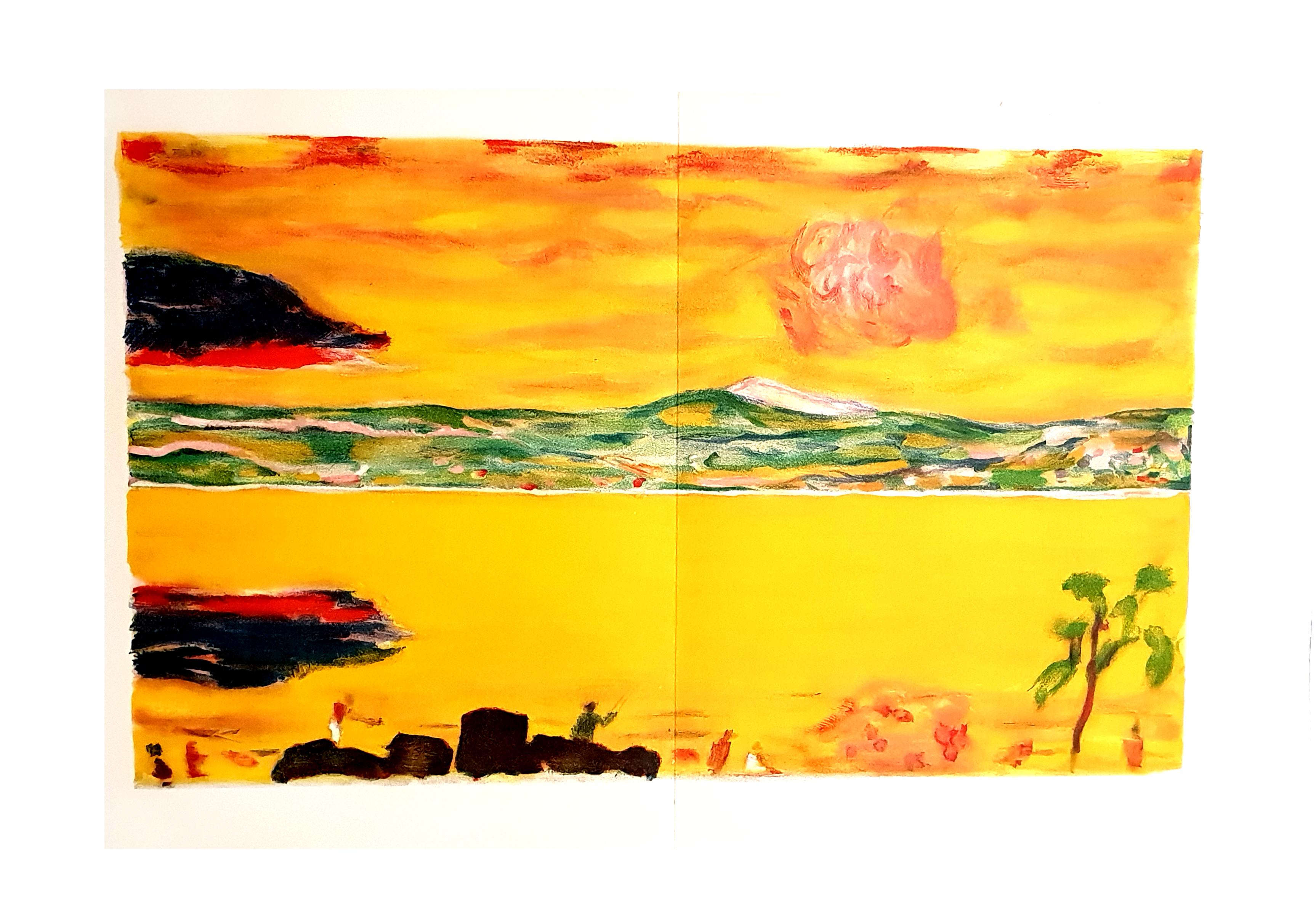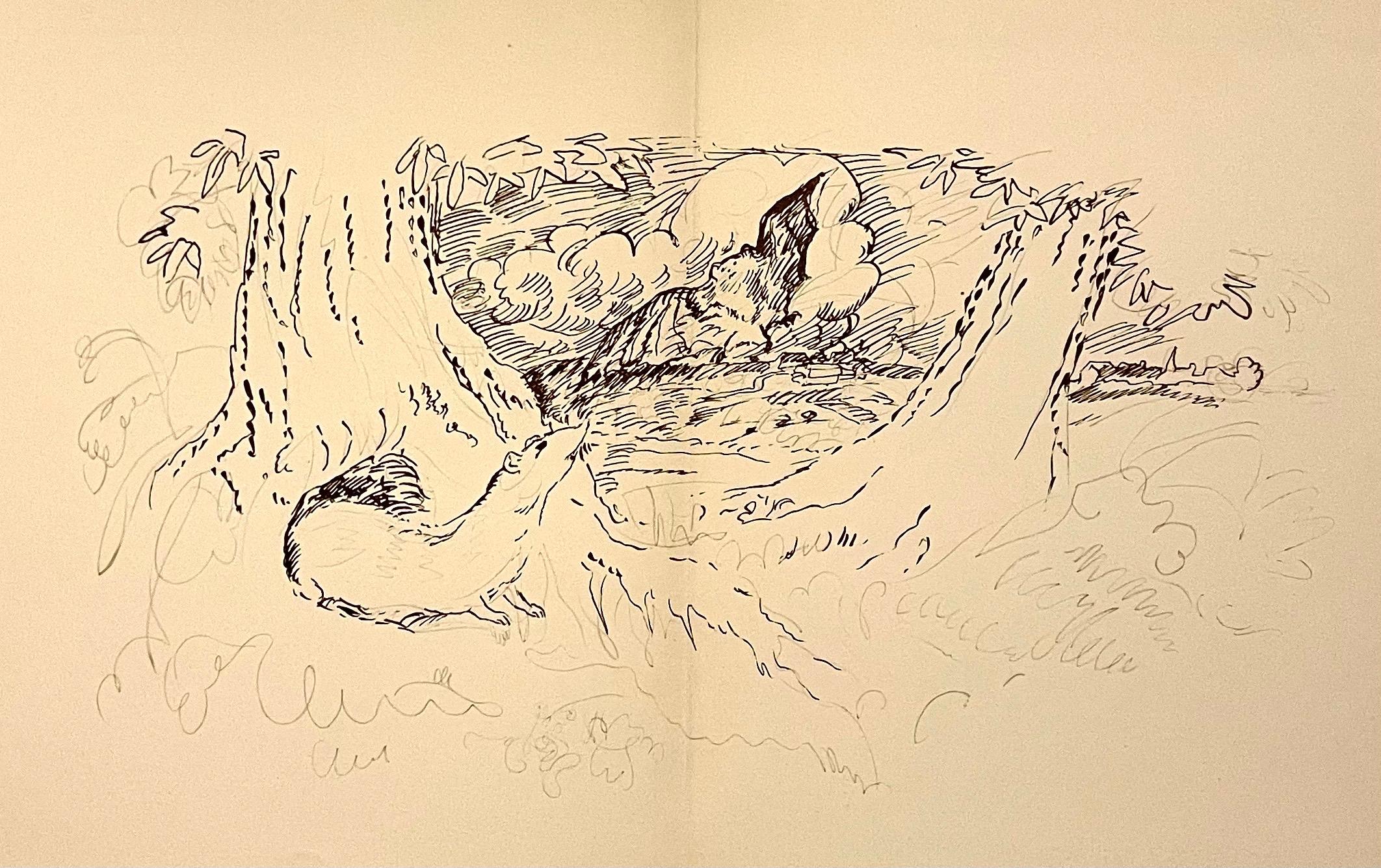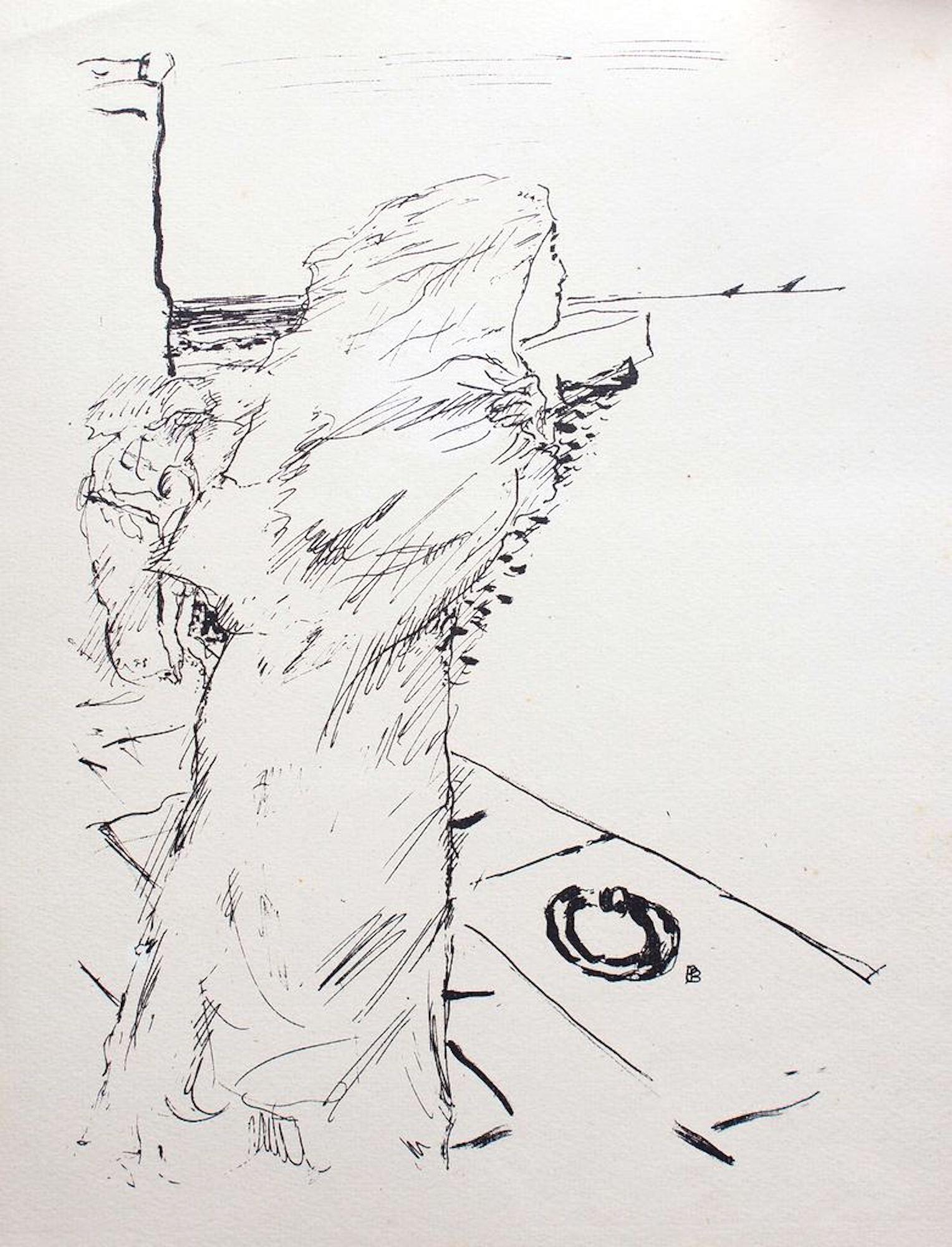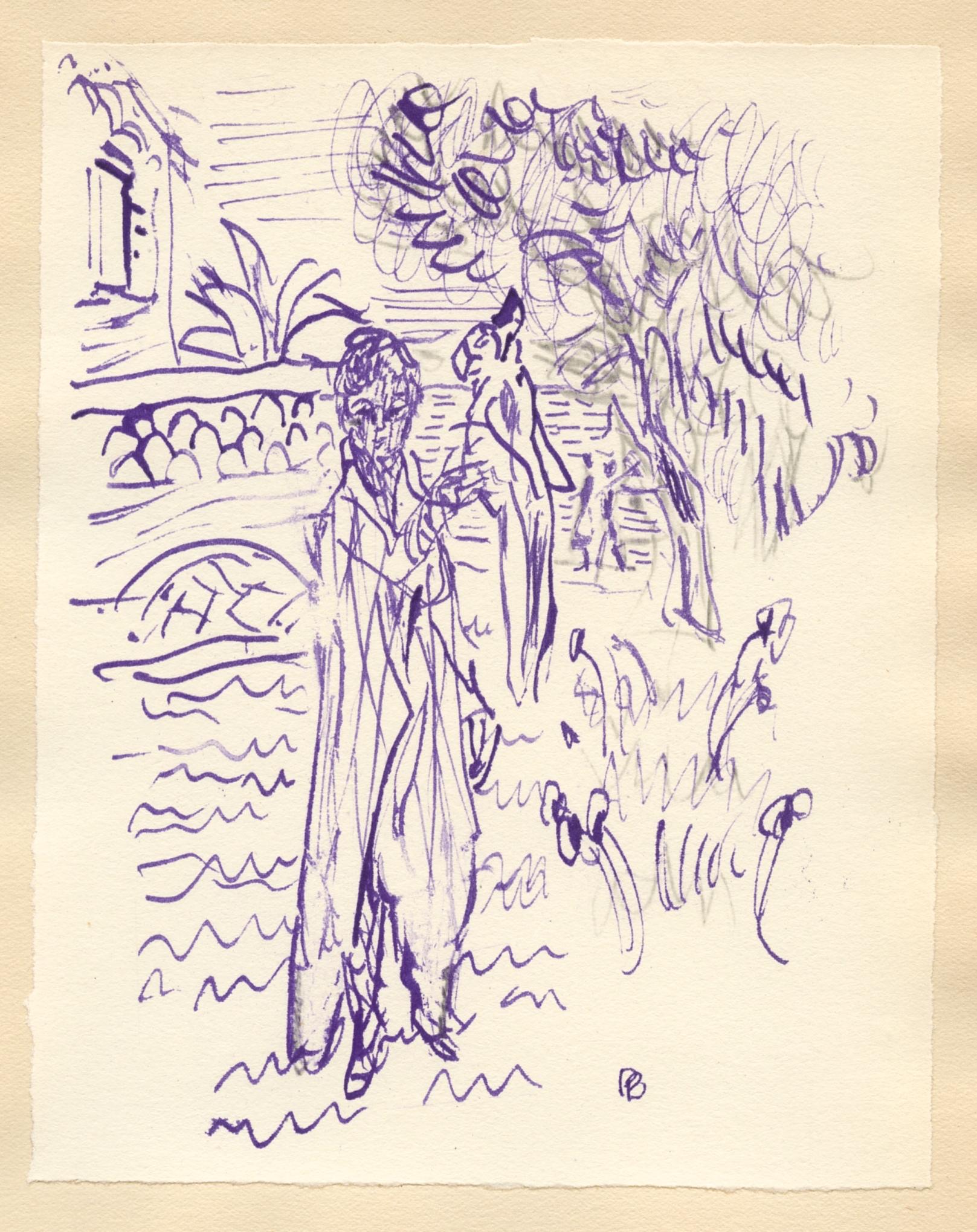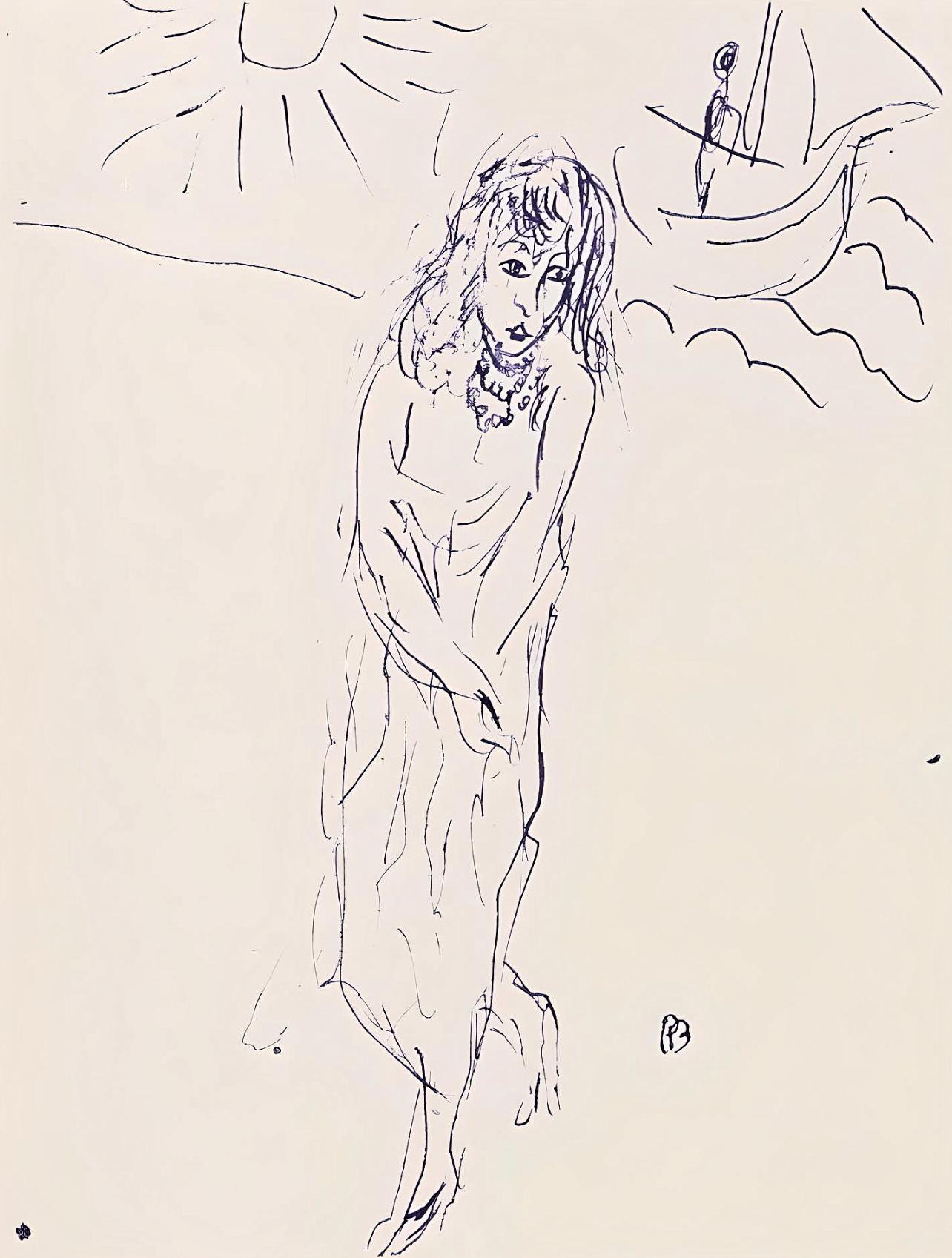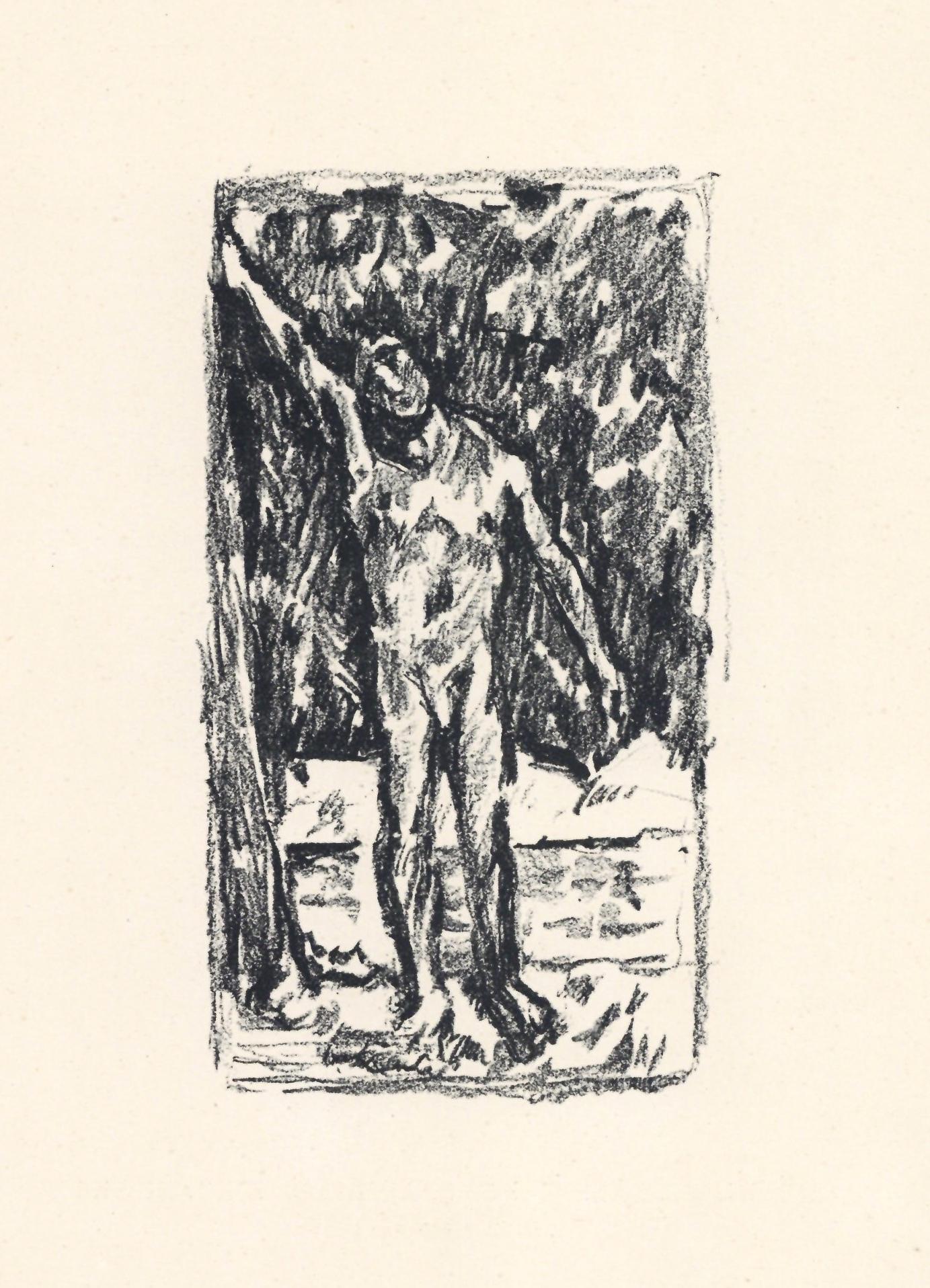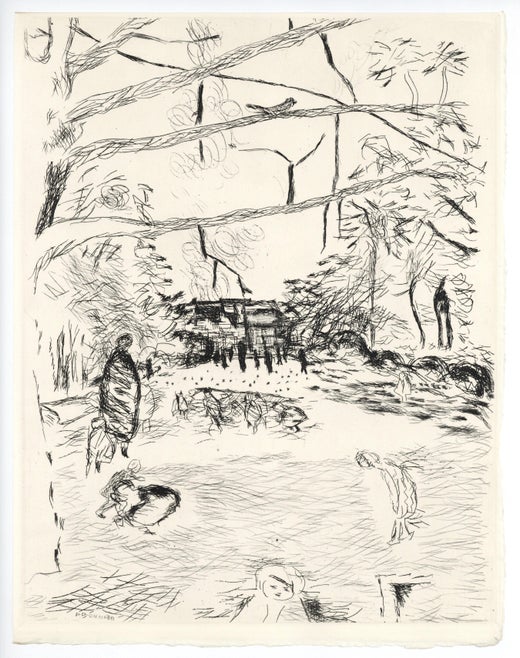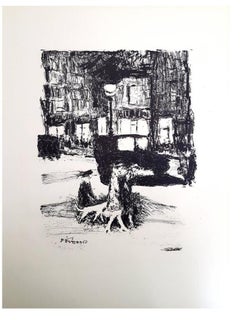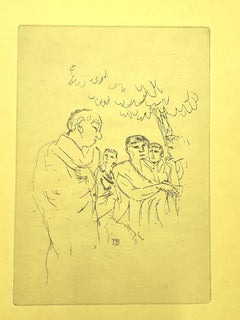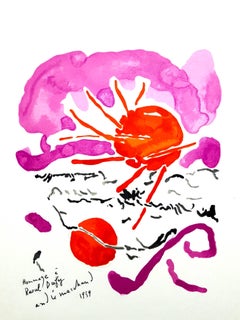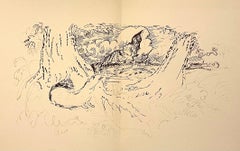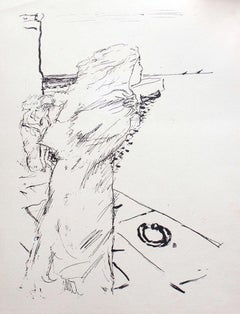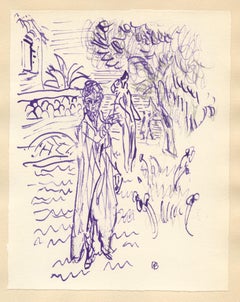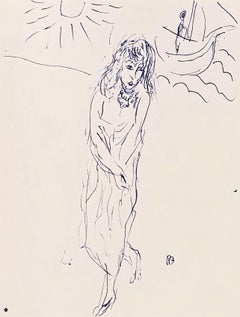Items Similar to Pierre Bonnard - The Sun - Original Lithograph
Want more images or videos?
Request additional images or videos from the seller
1 of 7
Pierre BonnardPierre Bonnard - The Sun - Original Lithograph1947
1947
$1,536.08
£1,168.99
€1,300
CA$2,150.27
A$2,369.43
CHF 1,228.98
MX$28,181.15
NOK 15,546.28
SEK 14,563.57
DKK 9,903.23
About the Item
Pierre Bonnard - The Sun
Original Lithograph
Dimensions: 32 x 24 cm
Verve . Revue Artistique et Litteraire. Vol. V, Nos 17 et 18.
Signed in the plate
Unumbered as issued
- Creator:Pierre Bonnard (1867-1947, French)
- Creation Year:1947
- Dimensions:Height: 12.6 in (32 cm)Width: 9.45 in (24 cm)Depth: 0.04 in (1 mm)
- Medium:
- Movement & Style:
- Period:
- Condition:
- Gallery Location:Collonge Bellerive, Geneve, CH
- Reference Number:1stDibs: LU16123778071
Pierre Bonnard
Pierre Bonnard was a French painter, illustrator and printmaker, born in 1867. He is known especially for the stylized decorative qualities of his paintings and his bold use of color. He painted landscapes, urban scenes, portraits and intimate domestic scenes, where the backgrounds, colors and painting style usually took precedence over the subject. He was a founding member of the post-impressionist group of avant garde painters, Les Nabis. He was also a leading figure in the transition from impressionism to modernism.
About the Seller
4.9
Gold Seller
Premium sellers maintaining a 4.3+ rating and 24-hour response times
Established in 2015
1stDibs seller since 2015
967 sales on 1stDibs
Typical response time: 1 hour
- ShippingRetrieving quote...Shipping from: Collonge Bellerive, Geneve, Switzerland
- Return Policy
More From This Seller
View AllPierre Bonnard - Sunset on the Mediterranean - Original Lithograph
By Pierre Bonnard
Located in Collonge Bellerive, Geneve, CH
Pierre Bonnard - Sunset on the Mediterranean
Original Lithograph
Dimensions: 36 x 54 cm
Verve . Revue Artistique et Litteraire. Vol. II, No 8.
Printed by Mourlot at the start of Worl...
Category
1940s Modern Figurative Prints
Materials
Lithograph
Pierre Bonnard - The Street - Original Etching
By Pierre Bonnard
Located in Collonge Bellerive, Geneve, CH
Pierre Bonnard - The Street - Original Lithograph
Dimensions : 13 x 10".
Paper : Rives vellum.
Edition : 225 copies.
1927
From Tableaux de Paris, Emile-Paul Freres, Paris
CHARLES...
Category
1920s Modern Figurative Prints
Materials
Etching
Pierre Bonnard - People - Original Etching
By Pierre Bonnard
Located in Collonge Bellerive, Geneve, CH
Pierre Bonnard - People - Original Etching
Circa 1940
Dimension : 30 x 23 cm
Signed in the plate with his initials.
Category
1940s Modern Figurative Prints
Materials
Etching
André Marchand (after) - Homage to Dufy - Lithograph
By André Marchand
Located in Collonge Bellerive, Geneve, CH
(after) André Marchand
Lithograph after a watercolor, published in the book "Lettre à mon peintre Raoul Dufy." Paris, Librairie Académique P...
Category
1940s Fauvist Animal Prints
Materials
Lithograph
Marc Chagall - Original Lithograph
By Marc Chagall
Located in Collonge Bellerive, Geneve, CH
Marc Chagall
Original Lithograph
1963
Dimensions: 32 x 24 cm
Reference: Chagall Lithographe 1957-1962. VOLUME II.
Condition : Excellent
Marc Chagall (born in 1887)
Marc Chagall was born in Belarus in 1887 and developed an early interest in art. After studying painting, in 1907 he left Russia for Paris, where he lived in an artist colony on the city’s outskirts. Fusing his own personal, dreamlike imagery with hints of the fauvism and cubism popular in France at the time, Chagall created his most lasting work—including I and the Village (1911)—some of which would be featured in the Salon des Indépendants exhibitions. After returning to Vitebsk for a visit in 1914, the outbreak of WWI trapped Chagall in Russia. He returned to France in 1923 but was forced to flee the country and Nazi persecution during WWII. Finding asylum in the U.S., Chagall became involved in set and costume design before returning to France in 1948. In his later years, he experimented with new art forms and was commissioned to produce numerous large-scale works. Chagall died in St.-Paul-de-Vence in 1985.
The Village
Marc Chagall was born in a small Hassidic community on the outskirts of Vitebsk, Belarus, on July 7, 1887. His father was a fishmonger, and his mother ran a small sundries shop in the village. As a child, Chagall attended the Jewish elementary school, where he studied Hebrew and the Bible, before later attending the Russian public school. He began to learn the fundamentals of drawing during this time, but perhaps more importantly, he absorbed the world around him, storing away the imagery and themes that would feature largely in most of his later work.
At age 19 Chagall enrolled at a private, all-Jewish art school and began his formal education in painting, studying briefly with portrait artist Yehuda Pen. However, he left the school after several months, moving to St. Petersburg in 1907 to study at the Imperial Society for the Protection of Fine Arts. The following year, he enrolled at the Svanseva School, studying with set designer Léon Bakst, whose work had been featured in Sergei Diaghilev's Ballets Russes. This early experience would prove important to Chagall’s later career as well.
Despite this formal instruction, and the widespread popularity of realism in Russia at the time, Chagall was already establishing his own personal style, which featured a more dreamlike unreality and the people, places and imagery that were close to his heart. Some examples from this period are his Window Vitebsk (1908) and My Fianceé with Black Gloves (1909), which pictured Bella Rosenfeld, to whom he had recently become engaged.
The Beehive
Despite his romance with Bella, in 1911 an allowance from Russian parliament member and art patron Maxim Binaver enabled Chagall to move to Paris, France. After settling briefly in the Montparnasse neighborhood, Chagall moved further afield to an artist colony known as La Ruche (“The Beehive”), where he began to work side by side with abstract painters such as Amedeo Modigliani and Fernand Léger as well as the avant-garde poet Guillaume Apollinaire. At their urging, and under the influence of the wildly popular fauvism and cubism, Chagall lightened his palette and pushed his style ever further from reality. I and the Village (1911) and Homage to Apollinaire (1912) are among his early Parisian works, widely considered to be his most successful and representative period.
Though his work stood stylistically apart from his cubist contemporaries, from 1912 to 1914 Chagall exhibited several paintings at the annual Salon des Indépendants exhibition, where works by the likes of Juan Gris, Marcel Duchamp and Robert Delaunay were causing a stir in the Paris art world. Chagall’s popularity began to spread beyond La Ruche, and in May 1914 he traveled to Berlin to help organize his first solo exhibition, at Der Sturm Gallery. Chagall remained in the city until the highly acclaimed show opened that June. He then returned to Vitebsk, unaware of the fateful events to come.
War, Peace and Revolution
In August 1914 the outbreak of World War I precluded Chagall’s plans to return to Paris. The conflict did little to stem the flow of his creative output, however, instead merely giving him direct access to the childhood scenes so essential to his work, as seen in paintings such as Jew in Green (1914) and Over Vitebsk (1914). His paintings from this period also occasionally featured images of the war’s impact on the region, as with Wounded Soldier (1914) and Marching (1915). But despite the hardships of life during wartime, this would also prove to be a joyful period for Chagall. In July 1915 he married Bella, and she gave birth to a daughter, Ida, the following year. Their appearance in works such as Birthday (1915), Bella and Ida by the Window (1917) and several of his “Lovers” paintings give a glimpse of the island of domestic bliss that was Chagall’s amidst the chaos.
To avoid military service and stay with his new family, Chagall took a position as a clerk in the Ministry of War Economy in St. Petersburg. While there he began work on his autobiography and also immersed himself in the local art scene, befriending novelist Boris Pasternak, among others. He also exhibited his work in the city and soon gained considerable recognition. That notoriety would prove important in the aftermath of the 1917 Russian Revolution when he was appointed as the Commissar of Fine Arts in Vitebsk. In his new post, Chagall undertook various projects in the region, including the 1919 founding of the Academy of the Arts. Despite these endeavors, differences among his colleagues eventually disillusioned Chagall. In 1920 he relinquished his position and moved his family to Moscow, the post-revolution capital of Russia.
In Moscow, Chagall was soon commissioned to create sets and costumes for various productions at the Moscow State Yiddish Theater...
Category
1960s Surrealist Figurative Prints
Materials
Lithograph
Georges Braque - Original Lithograph
By Georges Braque
Located in Collonge Bellerive, Geneve, CH
Georges Braque - Original Lithograph
1963
Dimensions: 32 x 24 cm
Andre Sauret, Monte Carlo
The father of Cubism
Three Cubist that distinguishes art historian periods were initiated and developed by Georges Braque: The Cubist Cézanne (1907-1909), Executive (1909-1912) and synthetic (1912-1922).
Post-Impressionist and fawn, Braque no longer adheres to the contingency of a decorative way or the other. Cézanne’s paintings exhibited at the Grand Palais during the retrospective of 1907 are a revelation: Cézanne sought and invented a pictorial language. In his footsteps, Braque went to the South with the reasons of the Master. He returned with Estaque landscapes and surprising Ciotat it keeps Cezanne geometric model and retains the “passages” continuity from one surface to another to create the sensation of “turning around” of the object represented. But he wants to go after the consequences of the vision of Cezanne. In his paintings Houses in L’Estaque (1908) it simplifies the volumes of houses, neglects detail by removing doors and windows: the plastic rhythm that builds the table. Large Nude , a masterpiece of the period, can be considered the first work of Cézanne cubism .
Systematizing and deepening Braque discoveries open the door analytical cubism. In 1909, his painting became more cerebral than sensual. The pattern is recreated in the two-dimensionality of the canvas, leaving aside any illusionistic perspective. In Still Life with Violin, objects are analyzed facets according to their characteristic elements, each facet referring to a particular view of the object. There are so many facets of points selected view: Table reflects the knowledge of the object and the ubiquity of the eye. Moreover, Braque is looking for the essence of the objects in the world rather than their contingency, which explains the absence of light source and use of muted colors (gray, ocher), contingent aspects of the object . But formal logic has stepped facets, erased any anecdote to the object and ultimately led to his painting a hermetic more marked on the edge of abstraction (see the series of Castle Roche-Guyon ).
Braque, anxious to keep the concrete and refusing at all costs that the logic of Cubism takes the paintings to abstract, reintroduced signs of reality in his paintings in 1912 marks the beginning of Synthetic Cubism. Historians speak of “signs of real” rather than reality because what interests Braque, this is not to put reality into a table, but to create a painting which, by its language, refers to the real. To do this, he invented two major techniques XX th century inclusions and contributions. The inclusions consist of painting objects that have no real depth, materials (wallpaper in Nature morte aux playing cards faux wood is a pictorial inclusion) or letters (calligraphic inclusion in Portuguese ), made first brush and a few months later stencil. Contributions are defined in contrast with the collage on canvas of foreign materials: glued or sand paper, sawdust, etc.. Regarding the collages, Braque used for the first time in September 1912 a piece of adhesive paper imitating faux wood Compote and Glass , then the packet envelope of tobacco Bock in 1912-1913, or an advertisement in Damier , 1913). Inputs and inclusions refer to an external object in the table, without “emulate” this object. Away from their appearances, objects are represented in closest essence of the objects in the real world sense.
This is also the time of Synthetic Cubism that Braque invented paper sculpture. There are, unfortunately, and no one is living proof of a photograph makes it possible to realize: Paper and paperboard.
Métamorphoses period(1961-1963).
In 1961, Georges Braque worked on a Greek head for the Louvre, which obsesses him, and he wishes to free his mind. He tried several times to bring out the paint and the result was unsatisfactory. He thinks the ultimate metamorphosis its Greek head projected in three dimensions. He calls in his studio of Baron Heger Loewenfeld, master lapidary, and he communicates his enthusiasm during the “fateful encounter.” Nine months later, in honor of the eighty years of Georges Braque, Heger Loewenfeld offers the Master of the ring Circe: the famous Greek head finally exorcised, carved in an onyx. Braque Loewenfeld then asked to identify other issues that haunt him.
From dated and signed by Georges Braque, Heger gouaches Loewenfeld shapes works in the fields of jewelery, lapidary art...
Category
1960s Modern Figurative Prints
Materials
Lithograph
You May Also Like
Pierre Bonnard ltd edition Lithograph Printed at Mourlot Paris 1958 Double Page
By Pierre Bonnard
Located in Surfside, FL
This is from a limited edition portfolio of original lithographs print Fernand Mourlot in Paris in 1958 from work done in collaboration with Bonnard which began in 1928.
This is f...
Category
20th Century Post-Impressionist Animal Prints
Materials
Lithograph
Traveler - Lithograph by Pierre Bonnard - 1930
By Pierre Bonnard
Located in Roma, IT
Monogram of the artist on plate. Pierre Bonnard was a French painter and printamaker, one of the most famous exponents of the Post-Impressionism. His first exhibition was at the Gale...
Category
1930s Post-Impressionist Figurative Prints
Materials
Lithograph
lithograph
By (after) Pierre Bonnard
Located in Henderson, NV
Medium: lithograph (after the drawing). This impression in violet ink was printed in France in 1944 for the rare "Correspondances" portfolio, published by Teriade in a limited editio...
Category
1940s Prints and Multiples
Materials
Lithograph
Bonnard, Composition (Terrasse 54), Pierre Bonnard Correspondences (after)
By Pierre Bonnard
Located in Southampton, NY
Lithograph on vélin d’Arches paper, mounted on vélin d’Arches backing sheet, as issued. Inscription: Unsigned and unnumbered, as issued. Good condition. Notes: From the album, Corres...
Category
1940s Modern Landscape Prints
Materials
Lithograph
$716 Sale Price
44% Off
Free Shipping
"Baigneur" original lithograph
By Pierre Bonnard
Located in Henderson, NV
Medium: original lithograph. Catalogue reference: Bouvet 82. This is an interpretation by Pierre Bonnard of one of Paul Cezannes's compositions, printed in 1914 and published in Pari...
Category
1910s Portrait Prints
Materials
Lithograph
Bonnard, Composition (Terrasse 54), Pierre Bonnard Correspondences (after)
By Pierre Bonnard
Located in Southampton, NY
Lithograph on vélin d’Arches paper, mounted on vélin d’Arches backing sheet, as issued. Inscription: Unsigned and unnumbered, as issued. Good condition. Notes: From the album, Corres...
Category
1940s Modern Landscape Prints
Materials
Lithograph
$716 Sale Price
44% Off
Free Shipping
